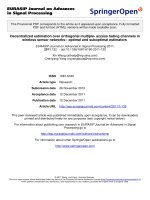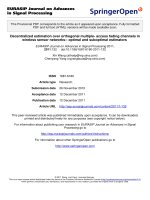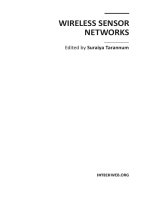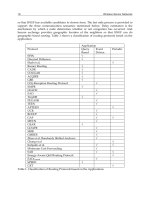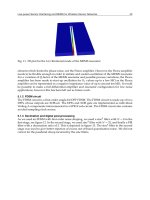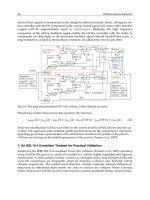- Trang chủ >>
- Khoa Học Tự Nhiên >>
- Vật lý
wireless sensor networks
Bạn đang xem bản rút gọn của tài liệu. Xem và tải ngay bản đầy đủ của tài liệu tại đây (4.57 MB, 326 trang )
WIRELESS SENSOR NETWORKS
Technology, Protocols, and Applications
KAZEM SOHRABY
DANIEL MINOLI
TAIEB ZNATI
WIRELESS SENSOR NETWORKSWIRELESS SENSOR NETWORKS
Technology, Protocols, and Applications
KAZEM SOHRABY
DANIEL MINOLI
TAIEB ZNATI
Copyright ß 2007 by John Wiley & Sons, Inc. All rights reserved.
Published by John Wiley & Sons, Inc., Hoboken, New Jersey.
Published simultaneously in Canada.
No part of this publication may be reproduced, stored in a retrieval system, or transmitted in any form or
by any means, electronic, mechanical, photocopying, recording, scanning, or otherwise, except as
permitted under Section 107 or 108 of the 1976 United States Copyright Act, without either the prior
written permission of the Publisher, or authorization through payment of the appropriate per-copy fee to
the Copyright Clearance Center, Inc., 222 Rosewood Drive, Danvers, MA 01923, (978) 750-8400, fax
(978) 750-4470, or on the web at www.copyright.com. Requests to the Publisher for permission should
be addressed to the Permissions Department, John Wiley & Sons, Inc., 111 River Street, Hoboken, NJ
07030, (201) 748-6011, fax (201) 748-6008, or online at />Limit of Liability/Disclaimer of Warranty: While the publisher and author have used their best efforts in
preparing this book, they make no representations or warranties with respect to the accuracy or
completeness of the contents of this book and specifically disclaim any implied warranties of
merchantability or fitness for a particular purpose. No warranty may be created or extended by sales
representatives or written sales materials. The advice and strategies contained herein may not be suitable
for your situation. You should consult with a professional where appropriate. Neither the publisher nor
author shall be liable for any loss of profit or any other commercial damages, including but not limited to
special, incidental, consequential, or other damages.
For general information on our other products and services or for technical support, please contact our
Customer Care Department within the United States at (800) 762-2974, outside the United States at
(317) 572-3993 or fax (317) 572-4002.
Wiley also publishes its books in a variety of electronic formats. Some content that appears in print may
not be available in electronic formats. For more information about Wiley products, visit our web site at
www.wiley.com.
Library of Congress Cataloging-in-Publication Data:
Sohraby, Kazem.
Wireless sensor networks: technology, protocols, and applications / by Kazem
Sohraby, Daniel Minoli, Taieb Znati.
p. cm.
ISBN 978-0-471-74300-2
1. Sensor networks. 2. Wireless LANs. I. Minoli, Daniel, 1952– II. Znati,
Taieb F.
III. Title.
TK7872. D48S64 2007
681
0
. 2–dc22
2006042143
Printed in the United States of America
10987654321
CONTENTS
Preface xi
About the Authors xiii
1 Introduction and Overview of Wireless Sensor Networks 1
1.1 Introduction, 1
1.1.1 Background of Sensor Network Technology, 2
1.1.2 Applications of Sensor Networks, 10
1.1.3 Focus of This Book, 12
1.2 Basic Overview of the Technology, 13
1.2.1 Basic Sensor Network Architectural Elements, 15
1.2.2 Brief Historical Survey of Sensor Networks, 26
1.2.3 Challenges and Hurdles, 29
1.3 Conclusion, 31
References, 31
2 Applications of Wireless Sensor Networks 38
2.1 Introduction, 38
2.2 Background, 38
2.3 Range of Applications, 42
2.4 Examples of Category 2 WSN Applications, 50
2.4.1 Home Control, 51
2.4.2 Building Automation, 53
2.4.3 Industrial Automation, 56
2.4.4 Medical Applications, 57
v
2.5 Examples of Category 1 WSN Applications, 59
2.5.1 Sensor and Robots, 60
2.5.2 Reconfigurable Sensor Networks, 62
2.5.3 Highway Monitoring, 63
2.5.4 Military Applications, 64
2.5.5 Civil and Environmental Engineering Applications, 67
2.5.6 Wildfire Instrumentation, 68
2.5.7 Habitat Monitoring, 68
2.5.8 Nanoscopic Sensor Applications, 69
2.6 Another Taxonomy of WSN Technology, 69
2.7 Conclusion, 71
References, 71
3 Basic Wireless Sensor Technology 75
3.1 Introduction, 75
3.2 Sensor Node Technology, 76
3.2.1 Overview, 76
3.2.2 Hardware and Software, 78
3.3 Sensor Taxonomy, 80
3.4 WN Operating Environment, 84
3.5 WN Trends, 87
3.6 Conclusion, 91
References, 91
4 Wireless Transmission Technology and Systems 93
4.1 Introduction, 93
4.2 Radio Technology Primer, 94
4.2.1 Propagation and Propagation Impairments, 94
4.2.2 Modulation, 101
4.3 Available Wireless Technologies, 103
4.3.1 Campus Applications, 105
4.3.2 MAN/WAN Applications, 120
4.4 Conclusion, 131
Appendix A: Modulation Basics, 131
References, 139
5 Medium Access Control Protocols for Wireless Sensor Networks 142
5.1 Introduction, 142
5.2 Background, 143
5.3 Fundamentals of MAC Protocols, 144
5.3.1 Performance Requirements, 145
5.3.2 Common Protocols, 148
vi CONTENTS
5.4 MAC Protocols for WSNs, 158
5.4.1 Schedule-Based Protocols, 161
5.4.2 Random Access-Based Protocols, 165
5.5 Sensor-MAC Case Study, 167
5.5.1 Protocol Overview, 167
5.5.2 Periodic Listen and Sleep Operations, 168
5.5.3 Schedule Selection and Coordination, 169
5.5.4 Schedule Synchronization, 170
5.5.5 Adaptive Listening, 171
5.5.6 Access Control and Data Exchange, 171
5.5.7 Message Passing, 172
5.6 IEEE 802.15.4 LR-WPANs Standard Case Study, 173
5.6.1 PHY Layer, 176
5.6.2 MAC Layer, 178
5.7 Conclusion, 192
References, 193
6 Routing Protocols for Wireless Sensor Networks 197
6.1 Introduction, 197
6.2 Background, 198
6.3 Data Dissemination and Gathering, 199
6.4 Routing Challenges and Design Issues in Wireless
Sensor Networks, 200
6.4.1 Network Scale and Time-Varying Characteristics, 200
6.4.2 Resource Constraints, 201
6.4.3 Sensor Applications Data Models, 201
6.5 Routing Strategies in Wireless Sensor Netwo rks, 202
6.5.1 WSN Routing Techniques, 203
6.5.2 Flooding and Its Variants, 203
6.5.3 Sensor Protocols for Information via Negotiation, 206
6.5.4 Low-Energy Adaptive Clustering Hierarchy, 210
6.5.5 Power-Efficient Gathering in Sensor Information
Systems, 213
6.5.6 Directed Diffusion, 215
6.5.7 Geographical Routing, 219
6.6 Conclusion, 225
References, 225
7 Transport Control Protocols for Wireless Sensor Networks 229
7.1 Traditional Transport Control Protocols, 229
7.1.1 TCP (RFC 793), 231
7.1.2 UDP (RFC 768), 233
CONTENTS vii
7.1.3 Mobile IP, 233
7.1.4 Feasibility of Using TCP or UDP for WSNs, 234
7.2 Transport Protocol Design Issues, 235
7.3 Examples of Existing Transport Control Protocols, 237
7.3.1 CODA (Congestion Detection and Avoidance), 237
7.3.2 ESRT (Event-to-Sink Reliable Transport), 237
7.3.3 RMST (Reliable Mul tisegment Transport), 239
7.3.4 PSFQ (Pump Slowly, Fetch Quickly), 239
7.3.5 GARUDA, 239
7.3.6 ATP (Ad Hoc Transport Protocol), 240
7.3.7 Problems with Transport Control Protocols, 240
7.4 Performance of Transport Control Protocols, 241
7.4.1 Congestion, 241
7.4.2 Packet Loss Recovery, 242
7.5 Conclusion, 244
References, 244
8 Middleware for Wireless Sensor Networks 246
8.1 Introduction, 246
8.2 WSN Middleware Principles, 247
8.3 Middleware Architecture, 248
8.3.1 Data-Related Functions, 249
8.3.2 Architectures, 252
8.4 Existing Middleware, 253
8.4.1 MiLAN (Middleware Linking Applications
and Networks), 253
8.4.2 IrisNet (Internet-Scale Resource-Intensive Sensor
Networks Services), 254
8.4.3 AMF (Adaptive Middleware Framework), 255
8.4.4 DSWare (Data Service Middleware), 255
8.4.5 CLMF (Cluster-Based Lightweight
Middleware Framework), 256
8.4.6 MSM (Middleware Service for Monitoring), 256
8.4.7 Em*, 256
8.4.8 Impala, 257
8.4.9 DFuse, 257
8.4.10 DDS (Device Database System), 258
8.4.11 SensorWare, 258
8.5 Conclusion, 259
References, 259
9 Network Management for Wireless Sensor Networks 262
9.1 Introduction, 262
9.2 Network Management Requirements, 262
viii CONTENTS
9.3 Traditional Network Management Models, 263
9.3.1 Simple Network Management Protocol, 263
9.3.2 Telecom Operation Map, 264
9.4 Network Management Design Issues, 264
9.5 Example of Management Architecture: MANNA, 267
9.6 Other Issues Related to Network Management, 268
9.6.1 Naming, 269
9.6.2 Localization, 269
9.7 Conclusion, 270
References, 270
10 Operating Systems for Wireless Sensor Networks 273
10.1 Introduction, 273
10.2 Operating System Design Issues, 274
10.3 Examples of Operating Systems, 276
10.3.1 TinyOS, 276
10.3.2 Mate, 277
10.3.3 MagnetOS, 278
10.3.4 MANTIS, 278
10.3.5 OSPM, 279
10.3.6 EYES OS, 279
10.3.7 SenOS, 280
10.3.8 EMERALDS, 280
10.3.9 PicOS, 281
10.4 Conclusion, 281
References, 281
11 Performance and Traffic Management 283
11.1 Introduction, 283
11.2 Background, 283
11.3 WSN Design Issues, 286
11.3.1 MAC Protocols, 286
11.3.2 Routing Protocols, 286
11.3.3 Transport Protocols, 287
11.4 Performance Modeling of WSNs, 288
11.4.1 Performance Metrics, 288
11.4.2 Basic Models, 289
11.4.3 Network Models, 292
11.5 Case Study: Simple Computation of the System Life Span, 294
11.5.1 Analysis, 296
11.5.2 Discussion, 298
11.6 Conclusion, 300
References, 300
Index 303
CONTENTS ix
PREFACE
The convergence of the Internet, communications, and information technologies,
coupled with recent engineering advances, is paving the way for a new generation
of inexpensive sensors and actuators, capable of achieving a high order of spatial
and temporal resolution and accuracy. The technology for sensing and control
includes sensor arrays, electric and magnetic field sensors, seismic sensors,
radio-wave frequency sensors, electrooptic and infrared sensors, laser radars, and
location and navigation sensors.
Advances in the areas of sensor design, materials, and concepts will further
decrease the size, weight, and cost of sensors and sensor arrays by orders of mag-
nitude and will increase their spatial and temporal resolution and accuracy. In the
very near future, it will become possible to integrate millions of sensors into sys-
tems to improve performance and lifeti me, and decrease life-cycle costs. According
to current market projections, more than half a billion nodes will ship for wireless
sensor applications in 2010.
The technology for sensing and control now has the potential for significant
advances, not only in science and engineering, but equally important, on a broad
range of applications relating to critical infrastructure protection and security,
health care, the environment, energy, food safety, production processing, quality
of life, and the economy. In addition to reducing costs and increasing efficiencies
for industries and businesses, wireless sensor networking is expected to bring con-
sumers a new generation of conveniences, including, but not limited to, remote-
controlled heating and lighting, med ical monitoring, automated grocery checkout,
personal health diagnosis, automated automob ile checkups, and child care.
This book is intended to be a high-quality textbook that provides a carefully
designed exposition of the important aspects of wireless sensor networks. The
xi
text provides thorough coverage of wireless sensor networks, including applica-
tions, communication and networking protocols, middleware, security, and manage-
ment. The book is targeted toward networking professionals, managers, and
practitioners who want to understand the benefits of this new technology and
plan for its use and deployment. It can also be used to support an introductory
course in the field of wireless sensor networks at the advanced undergraduate or
graduate levels.
At this time there is a limited number of textbooks on the subject of wireless
sensor networks. Furthermore, most of these books are written with a specific focus
on selected subjects related to the field. As such, the coverage of many important
topics in these books is either inadequate or missing. With the ever-increasing
popularity of wireless sensor networks and their tremendous potential to penetrate
multiple aspects of our lives, we believe that this book is timely and addresses the
needs of a growing community of engineers, network professionals and managers,
and educators. The book is not so encyclopedic as to overwhelm nonexperts in
the field. The text is kept to a reasonable length, and a concerted effort has been
made to make the coverage comprehensive and self-contained, and the material easily
understandable and exciting to read.
Acknowledgments
First author would like to acknowledge the contributions of his postdoctoral fellow,
Dr. Chonggang Wang, while at the University of Arkansas, in the preparation of
some of the mater ial in this book.
xii PREFACE
ABOUT THE AUTHORS
Daniel Minoli has many years of telecom, networking, and IT experience with end
users, carriers, academia, and venture capitalists, including work at ARPA think
tanks, Bell Telephone Laboratories, ITT, Prudential Securities, Bell Communica-
tions Research (Bellcore/Telcordia), AT&T, Capital One Financial, SES Americom,
New York University, Rutgers University, Stevens Institute, and Societe
´
General de
Financiament de Quebec (1975–2001). Recently, he played a founding role in the
launching of two networking companies through the high-tech incubator Leading
Edge Networks Inc., which he ran in the early 2000s: Global Wireless Services, a
provider of broadband hotspot mobile Internet and hotspot VoIP services to high-
end marinas; and InfoPort Communications Group, an optical and gigabit Ethernet
metropolitan carrier supporting Data Center/SAN/channel extension and Grid Com-
puting network access services (2001–2003). Currently, he is working on IPTV,
DVB-H, satellite technology and (wireless) emergency communications systems.
Mr. Minoli has worked extensively in the field of wireless and over the years has
published approximately 20 papers on the topic. His work in wireless started in the
mid-1970s with extensive efforts on ARPA-sponsored research on wireless packet
networks. In the early 1980s he was involved in the design of high-resilience radio
networks. In the mid-1980s he was involved in designing and deploying VSAT net-
works, including work on correlated traffic profiles. Recently, he has been involved
with the novel design of Wi-Fi hotspot networks for interference-laden public
places such as marinas, and has written the first book on the market on hotspot net-
working: Hotspot Networks—Wi-Fi for Public Access Locat ions (McGraw-Hill,
2003). He has also been involved in the planning and deployment of high-density
enterprise IEEE 802.11b/g/e/i systems and VoWi-Fi. He recently acted as an expert
witness in a (successful) $11 billion lawsuit regarding a wireless air-to-ground
xiii
communication system for airplane-based telephony and information services. He
has also done work on wireless networking applications of nanotechnology (quan-
tum cascade lasers for free-space optics) and has just published a book on that topic
with Wiley (2005).
Mr. Minoli is the author of a number of books on information technology, tele-
communications, and data communications. He has also written columns for Com-
puterWorld, NetworkWorld, and Network Computing (1985–1995). He has spoken
at 80 industry conferences and has taught at New York University (Information
Technology Institute), Rutgers University, Stevens Institute of Technology, and
Monmouth University (1984–2003). He was a technology analyst at-large for
Gartner/DataPro (1985–2001). On their behalf, based on extensive hands-on work
at financial firms and carriers, he tracked technologies and authored numerous
CTO/CIO-level technical/architectural scans in the area of telephony and data
communications systems, including topics on security, disaster recovery, IT
outsourcing, network management, LANs, WANs (ATM and MPLS), wireless
(LAN and public hotspot), VoIP, network design/economics, carrier networks
(such as metro Ethernet and CWDM/DWDM), and e-commerce. Over the years
he has advised venture capitalists for investments of $150 million in a dozen high-
tech companies.
Dr. Kazem Sohraby is a professor of electrical engineering in the College of Engi-
neering at the University of Arkansas, Fayetteville, where he also serves as profes-
sor and head at the Department of Computer Science and Computer Engineering.
Prior to the University of Arkansas engagement, Dr. Sohraby was with Bell
Laboratories, Lucent Technologies, and AT&T Bell Labs. He has also served as
director of the interdisciplinary academic program on telecommunications manage-
ment at Stevens Institute of Technology, and before that as head of the Network
Planning Department at Computer Sciences Corporation. At Bell Labs he played a
key role in the research and development of high-tech communications, computing,
network management, security, and other information technologies area. He
spend most of his career at Bell Labs in the Advanced Communications Technol-
ogies Center, the Mathematical Sciences Research Center (Mathematics of Net-
works and Systems), and in forward-looking organizations working on future-
generation switching and transmission technologies. In its golden age, Bell
La bs was the world leader in research and developm ent of new computing and
communications technologies, and has created innumerous innovations in the
advancement of communications and computer networking. Dr. Sohraby’s contri-
butions at Bell Labs, demonstrated by over 20 patents filed on his behalf and
many of his publications, represent an outstanding benchmark in computer and
communications technologies leadership.
Dr. Sohraby has generated numerous publications, including a book entitled
Control and Performance in Packet, Circuit, and ATM Networks (Kluwer Publish-
ers, 1995). He is a distinguished lecturer of the IEEE Communications Society and
served as its president’s representative on the Committee on Communications and
Information Policy (CCIP). He served on the Education Committee of the IEEE
xiv ABOUT THE AUTHORS
Communications Society, and is on the editor ial boards of several publications.
Dr. Sohraby received the B.S., M.S., and Ph.D. degrees in electrical engineering,
has a graduate education in computer science, and received an M.B.A. degree
from the Wharton School of the University of Pennsylvania.
Dr. Taieb Znati is professor in the Department of Computer Science, with a joint
appointment in the telecommunication program (DIS) and in computer engineering
(EE) at the University of Pittsburgh. Prof. Znati’s interests include routing and con-
gestion control in high-speed networks, multicasting, access protocols in local and
metropolitan area networks, quality of service support in wired and wireless net-
works, performance analysis of network protocols, multimedia applications, distrib-
uted systems, and agent-based internet applications. Recent work has focused on
the design and anal ysis of network protocols for wired and wireless communica-
tions, sensor networks, network security, agent-based technology with collaborative
environments, and middleware. He is coedi tor of the book Wireless Sensor Net-
works (Kluwer Publishers, 2004) and has published extensively on the topic.
Prof. Znati earned a Ph.D. degree in computer science, September 1988, at
Michigan State University. He also has a Master of Science degree in computer
science from Purdue University, December 1981. In addition, he earn ed other aca-
demic degrees in Europe. Currently, he is a professor in the Department of Com-
puter Science, with a joint appointment in the telecommunication program (School
of Library and Information Science), at the University of Pittsburgh. He recently
took a leave from the university to serve as senior program director for networking
research at the National Science Foundation. He is also the ITR coordinating com-
mittee chair. In the late 1990s he was an associate professor in the Department of
Computer Science, with a joint appointment in the telecommunication program
(School of Library and Information Science) at the University of Pittsburgh. In
the early 1990s he was an assistant professor at the same institution. During the
1980s he held a number of industry positions, including the position of system man-
ager for the management of VAX VMS-cluster daily operations at the Case Center
for Computer-Aided Design at Michigan State University. He also held the position
of network coordinator, with responsibility for the development of networking
plans for the Coll ege of Engineering at Michigan State University.
Prof. Znati has chaired several conferences and workshops, including confer-
ences and workshops on wireless sensor networks. He is on the editorial board
of several scientific journals in networking and distributed systems. He is frequently
invited to present lectures and tutorials and to participate in panels related to net-
working and distributed multimedia topics in the United States and abroad.
ABOUT THE AUTHORS xv
1
INTRODUCTION AND OVERVIEW
OF WIRELESS SENSOR NETWORKS
1.1 INTRODUCTION
A sensor network
1
is an infrastructure comprised of sensing (measuring), comput-
ing, and communication elements that gives an administrator the ability to instru-
ment, observe, and react to events and phenomena in a specified environment. The
administrator typically is a civil, governmental, commercial, or industrial entity.
The environment can be the physical world, a biological system, or an information
technology (IT) framework. Network(ed) sensor systems are seen by observers as
an important technology that will experience major deployment in the next few
years for a plethora of applications, not the least being national security
[1.1–1.3]. Typical applications include, but are not limited to, data collection,
monitoring, surveillance, and medical telemetry. In addition to sensing, one is
often also interested in control and activation.
There are four basic components in a sensor network: (1) an assembly of distrib-
uted or localized sensors; (2) an interconnecting network (usually, but not always,
wireless-based); (3) a central point of information clustering; and (4) a set of com-
puting resources at the central point (or beyond) to handle data correlation, event
trending, status querying, and data mining. In this context, the sensing and computa-
tion nodes are considered part of the sensor network; in fact, some of the computing
Wireless Sensor Networks: Technology, Protocols, and Applications, by Kazem Sohraby, Daniel Minoli,
and Taieb Znati
Copyright # 2007 John Wiley & Sons, Inc.
1
Although the terms networked sensors and network of sensors are perhaps grammatically more correct
than the term sensor network, generally in this book we employ the de facto nomenclature sensor network.
1
may be done in the network itself. Because of the potentially large quantity of data
collected, algorithmic methods for data management play an important role in sen-
sor networks. The computation and communication infrastructure associated with
sensor networks is often specific to this environment and rooted in the device-
and application-based nature of these networks. For example, unlike most other set-
tings, in-network processing is desirable in sensor networks; furthermore, node
power (and/or battery life) is a key design consideration. The information collected
is typically parametric in nature, but with the emergence of low-bit-rate video
[e.g., Moving Pictures Expert Group 4 (MPEG-4)] and imaging algorithms, some
systems also support these types of media.
In this book we provide an exposition of the funda mental aspects of wireless
sensor networks (WSNs). We cover wireless sensor network technology, applica-
tions, communication techniques, networking protocols, middleware, security,
and system management. There already is an extensive bibliography of research
on this topic; the reader may wish, for example, to consult [1.4] for an up-to-
date list. We seek to systematize the extensive paper and conference literature
that has evolved in the past decade or so into a cohesive treatment of the topic.
The book is targeted to communications developers, man agers, and practitioners
who seek to understand the benefits of this new technology and plan for its use
and deployment.
1.1.1 Background of Sensor Network Technology
Researchers see WSNs as an ‘‘exciting emerging domain of deeply networked
systems of low-power wireless motes
2
with a tiny amount of CPU and memory,
and large federated networks for high-resolution sensing of the environment’’
[1.93]. Sensors in a WSN have a variety of purposes, functions, and capabilities.
The field is now advancing under the push of recent technological advances and
the pull of a myriad of potential applications. The rada r networks used in air traffic
control, the national electrical power grid, and nationwide weather stations
deployed over a regular topographic mesh are all examples of early-deployment
sensor networks; all of these systems, however, use specialized computers and
communication protocols and consequently, are very expensive. Much less expen-
sive WSNs are now being planned for novel applications in physical security, health
care, and commerce. Sensor networking is a multidisciplinary area that involves,
among others, radio and networking, signal processing, artificial intelligence, data-
base management, systems architectures for operator-friendly infrastructure admin-
istration, resource optimization, power management algorithms, and platform
technology (hardware and software, such as operating systems) [1.5]. The applica-
tions, networking principles, and protocols for these systems are just beginning to
be developed [1.48]. The near-ubiquity of the Internet, the advancements in wire-
less and wireline communications technologies, the network build-out (particularly
2
The terms sensor node, wireless node, smart dust, mote, and COTS (commercial off the shelf) mote are
used somewhat interchangeably; the most general terms, however, are sensor node and wireless node.
2 INTRODUCTION AND OVERV IEW OF WIRELESS SEN SOR NETWORKS
in the wireless case), the developments in IT (such as high-power processors, large
random-access memory chips, digital signal processing, and grid computing),
coupled with recent engineering advances, are in the aggregate opening the door
to a new generation of low-cost sensors and actuators that are capable of achieving
high-grade spatial and temporal resolution.
The technology for sensing and control includes electric and magnetic field sen-
sors; radio-wave frequency sensors; optical-, electrooptic-, and infrared sensors;
radars; lasers; location/navigation sensors; seism ic and pressure-wave sensors;
environmental parameter sensors (e.g., wind, humidity, heat); and biochemical
national security–oriented sensors. Today’s sensors can be described as ‘‘smart’’
inexpensive devices equipped with multiple onboard sensing elements; they are
low-cost low-power untethered multifunctional nodes that are logically homed to
a cent ral sink node. Sensor devices, or wireless nodes (WNs), are also (sometimes)
called motes [1.91]. A stated commercial goal is to develop complete microelectro-
mechanical systems (MEMSs)–based sensor systems at a volume of 1 mm
3
[1.93].
Sensors are internetworked via a series of multihop short-distance low-power wire-
less links (particularly within a defined sensor field); they typically utilize the
Internet or some other network for long-haul delivery of information to a point
(or points) of final data aggregation and analysis. In general, within the sensor field,
WSNs employ contention-oriented random-access channel sharing and transmis-
sion techniques that are now incorporated in the IEEE 802 family of standards;
indeed, these techniques were originally developed in the late 1960s and 1970s
expressly for wireless (not cabled) environments and for large sets of dispersed
nodes with limited channel-management intelligence [1.6]. However, other channel-
management techniques are also available.
Sensors are typically deployed in a high-density manner and in large quantities:
A WSN consists of densely distributed nodes that support sensing, signal processing
[1.7], embedded computing, and connectivity; sensors are logically linked by self-
organizing means [1.8–1.11] (sensors that are deployed in short-hop point-to-point
master–slave pair arrangements are also of interest). WNs typically transmit infor-
mation to collecting (monitoring) stations that aggregate some or all of the infor-
mation. WSNs have unique characteristics, such as, but not limited to, power
constraints and limited battery life for the WNs, redundant data acquisition, low
duty cycle, and, many-to-one flows. Consequently, new design methodologies are
needed across a set of disciplines including, but not limited to, information trans-
port, network and operational management, confidentiality, integrity, availability,
and, in-network/local processing [1.12]. In some cases it is challenging to collect
(extract) data from WNs because connectivity to and from the WNs may be inter-
mittent due to a low-battery status (e.g., if these are dependent on sunlight to
recharge) or other WN malfunction.
3
Furthermore, a lightweight protocol stack is
desired. Often, a very large number of client units (say 64k or more) need to be
supported by the system and by the addressing apparatus.
3
Special statistical algorithms may be employed to correct from biases caused by erratic or poorly placed
WNs [1.91].
INTRODUCTION
3
Sensors span several orders of magnitude in physical size; they (or, at least some
of their components) range from nanoscopic-scale devices to mesoscopic-scale
devices at one end, and from microscopic-scale devices to macroscopic-scale
devices at the other end. Nanoscopic (also known as nanoscale ) refers to objects
or devices on the order of 1 to 100 nm in diameter; mesoscopic scale refers to
objects between 100 and 10,000 nm in diameter; the microscopic scale ranges
from 10 to 1000 mm, and the macroscopic scale is at the millimeter-to-meter range.
At the low end of the scale, one finds, among others, biological sensors, small pas-
sive microsensors (such as Smart Dust
4
), and ‘‘lab-on-a-chip’’ assemblies. At the
other end of the scale one finds platforms such as, but not limited to, identity
tags, toll collection devices, controllable weather data collection sensors, bioterror-
ism sensors, radars, and undersea subm arine traffic senso rs based on sonars.
5
Some
refer to the latest generation of sensors, especially the miniaturized sensors that
are directly embedded in som e physical infrastructure, as microsensors. A senso r
network suppor ts any type of generic sensor; more narrowly, networked micro-
sensors are a subse t of the general family of sensor networks [1.13]. Microsensors
with onboard processing and wireless interfaces can be utilized to study and monitor
a variety of phenomena and environments at close proximity.
Sensors can be simple point elements or can be multipoint detection arrays.
Typically, nodes are equipped with one or more application-specific sensors and
with on-node signal processing capabilities for extraction and manipulation (pre-
processing) of physical environment information. Embedded network sensing refers
to the synergistic incorporation of microsensors in structures or environments;
embedded sensing enables spatially and temporally dense monitoring of the system
under consideration (e.g., an environment, a building, a battlefield). Sensors may be
passive and/or be self-powered; farther down the power-consumption chain, som e
sensors may require relatively low power from a battery or line feed [1.14–1.19]. At
the high end of the power-consumption chain, some sensors may require very high
power feeds (e.g., for radars).
Sensors facilitate the instrumenting and controlling of factories, offices, homes,
vehicles, cities, and the ambiance, especially as commercial off-the-shelf technol-
ogy becomes available. With sensor network technol ogy (specifically, with
embedded networked sensing), ships, aircraft, and buildings can ‘‘self-detect’’
structural faults (e.g., fatigue-induced cracks). Places of public asse mbly can be
instrumented to detect airborne agents such as toxins and to trace the source of
the contamination should any be present (this can also be done for ground and
underground situations). Earthquake-oriented sensors in buildings can locate poten-
tial survivors and can help assess structural damage; tsunami-alerting sensors are
useful for nations with extensive coastlines. Sensors also find extensive applicability
on the battlefield for reconnaissance and surveillance [1.20].
4
The Smart Dust mote is an autonomous sensing, computing, and communication system that uses the
optical visible spectrum for transmission [1.89]. They are tiny inexpensive sensors developed by UC–
Berkeley engineers (see also Chapter 2).
5
Although satellites can be used to support sensing, we do not include them explicitly in the technical
discussion.
4 INTRODUCTION AND OVERV IEW OF WIRELESS SEN SOR NETWORKS
In this book we emphasize the emergence of open standards in support of WSNs;
standardization drives commercialization of the technology. ‘‘New things’’ gener-
ally start out as advanced research projects pursued at government and/or academic
labs. Typically, pure and/or applied research goes on for a number of years. At this
early stage, specialized, one-of-a-kind, complex, and noninterworking prototypes,
pilots, or deployments are common. Eventually, however, if a new thing is to
become a ubiquitous technology, commercial-level open standards, chipsets, and
products are needed, which must meet commercial service- and operational-level
agreements in terms of reliability, cost, usability, durability, and simplicity. Following
is a sample classification of research topics by frequency of publication based on a
fair-sized sample of recent scientific WSN articles.
Deployment 9.70%
Target tracking 7.27%
Localization 6.06%
Data gathering 6.06%
Routing and aggregation 5.76%
Security 5.76%
MAC protocols 4.85%
Querying and databases 4.24%
Time synchronization 3.64%
Applications 3.33%
Robust routing 3.33%
Lifetime optimization 3.33%
Hardware 2.73%
Transport layer 2.73%
Distributed algorithms 2.73%
Resource-aware routing 2.42%
Storage 2.42%
Middleware and task allocation 2.42%
Calibration 2.12%
Wireless radio and link characteristics 2.12%
Network monitoring 2.12%
Geographic routing 1.82%
Compression 1.82%
Taxonomy 1.52%
Capacity 1.52%
Link-layer techniques 1.21%
Topology control 1.21%
Mobile nodes 1.21%
Detection and estimation 1.21%
Diffuse phenomena 0.91%
Programming 0.91%
Power control 0.61%
Software 0.61%
Autonomic routing 0.30%
INTRODUCTION 5
To appreciate the importance and criticality of simplicity-fostering standards in
making a technology a pervasive reality, one need only study the progression of
late-1960s wireless random-access systems (e.g., [1.21–1.23]) to the present-day
LANs and WLAN/2.5G/3G systems (e.g., [1.6]); or the early-1970s ARPAnet
(e.g., among many, [1.24]) to the present-day Internet (e.g., [1.25]); or the mid-
1970s Voice Over Packet (e.g., [1.26–1.30]) to the current Voice Over IP tech-
nology (e.g., [1.31,1.32]); or the late-1980s video compression (e.g., [1.33]) to
the current MPEG-2 and MPEG-4 digital video transmission revolution (e.g.,
[1.34]). See Figure 1.1 for a pictorial representation of the shift in technical empha-
sis over time.
Indeed, at this juncture, sensor networking is becoming a burgeoning field; there
is currently extensive interest in this discipline not only from academia and govern-
ment, but also from developers, manufacturers, startup companies, investors, and
original equipment manufacturers (OEMs). According to industry observers, the
wireless sensor market is now poised to take off commercially. Current market
reports indicate that more than half a billion nodes are expected to ship for wireless
sensor applications by 2010, for a market worth more than $7 billion [1.35]. As an
example, advanced radio-frequency integrated circuits (RFICs) are now available
for $3 or less, and smart sensor integrated circuits have become commonplace
[1.35]. In the next few years, advances in the areas of sensor design and materials
that have taken place in the recent past will lead, almost assuredly, to significant
reductions in the size, weight, power consumption, and cost of sensors and sensor
arrays; these advances will also affect an increase in their spatial and temporal
resolution, along with improved measuring accuracy.
Implementations of WSNs have to address a set of technical challenges; how-
ever, the move toward standardization will, in due course, minimize a number of
these challenges by addressing the issues once and then result in off-the-shelf chip-
sets and components. A current research and development (R&D) challenge is to
develop low-power communication with low-cost on-node processing and self-
organizing connectivity/protocols; another critical challenge is the need for
extended temporal operation of the sensing node despite a (typically) limited power
supply (and/or battery life). In particular, the architecture of the radio, including
the use of low-power circuitry, must be properly selected. In practical terms this
implies low power consumption for trans mission over low-bandwidth channels
Intensity
R&D effort
Total effort
Engineering/
Implementation effort
Time
Figure 1.1 Shift and progression in emphasis over time in support of commercialization.
6
INTRODUCTION AND OVERV IEW OF WIRELESS SEN SOR NETWORKS



